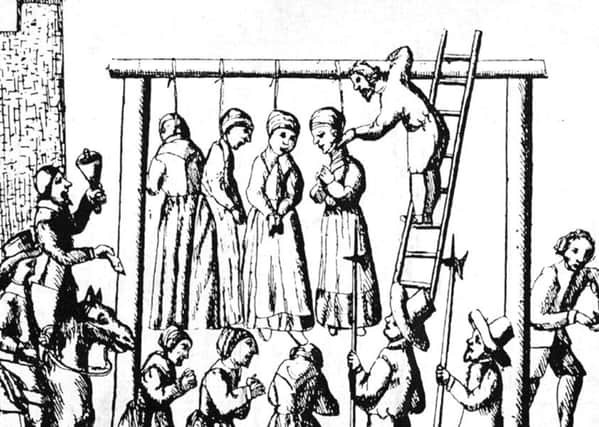During the 420th anniversary of the Great Witch Hunt of Scotland, Dawn Renton discovers how thousands were killed thanks to the Scottish Parliament's deadliest ever Act.


It would become known the world over as the Salem Witch Trials but how many have heard of our own witch trials, here in Scotland?
This year marks the 420th anniversary of the Great Witch Hunt, which took place between March and October 1597 – nearly a century before the infamous events in Salem.
Advertisement
Hide AdAdvertisement
Hide AdInstigated by James VI, the King of Scotland, it was the second of five nationwide hunts in Scottish history, the others being carried out in 1590 to 1591, 1628 to 1631, 1649 to 1650 and 1661 to 1662.
The trials became deadly with the introduction of the Scottish Witchcraft Act on June 4, 1563.
Allowing the execution of alleged witches to be legalised, the Act resulted in hundreds of unnecessary deaths with close to 400 people put on trial and a suspected 200 sentenced to death over a six month period in 1597.
Guilt was proved by the accused being unable to shed tears at will; being unable to recite the Lord’s Prayer – and the slightest hesitation at a single word was enough; or having the “devil’s marking” on some part of their body.
Advertisement
Hide AdAdvertisement
Hide AdAn unusual birthmark was often deemed to be a mark made by Satan.
Having a red, blue or purple mark on your body was thought to have been made with the Devil’s claw.
Swimming the witch was another well known method of proving guilt – and it certainly didn’t make it easy to establish innocence.
It consisted of putting the accused person in a pond and allowing them to sink or swim. If they drowned, it was believed they were innocent because none of the powers of darkness came to their aid.
Advertisement
Hide AdAdvertisement
Hide AdIf they swam, or were fortunate enough to float, it was deemed proof of guilt.
All of these methods were used during the 1597 Witch Hunt, perhaps the least documented of the five nationwide hunts.
As with the latter ones, it was conducted by local courts under the supervision of royal commissions but, in contrast to the others, it was not documented by the central authorities so many local records went missing.
Wiccan historian Clayre Mitchell said: “It’s not really known what the catalyst behind the trials was.
Advertisement
Hide AdAdvertisement
Hide Ad“At the time, Scotland as a whole was experiencing a political conflict between the monarch and the Presbyterian Church, as well as plague and famine.
“And James VI was consumed by his paranoia over conspiracies to kill him, which only added fuel to the fire. People across the country lived in fear of being accused.”
Once that fear took over, anything unpleasant that happened to someone could be blamed on witchcraft.
“Everyone was regarded with suspicion – families, friends and neighbours,” Clayre explained.
Advertisement
Hide AdAdvertisement
Hide Ad“The people lived in constant terror of not knowing if they were safe or if they were going to be accused of being a witch. No one was exempt, even noblemen were at risk.
“People deemed a bit odd were easy targets for those on a witch hunt.”
James VI gave his support to the prosecution of witches and wrote a treaty titled Daemonologie in 1597.
In it he discussed his opinions and experiences with witchcraft, sorcery, and magic.
Advertisement
Hide AdAdvertisement
Hide AdThe witch hunt seemed to have been most active in Fife, Perthshire, Glasgow, Stirlingshire and Aberdeenshire, between March and October.
The earliest cases recorded took place in Slain, north of Aberdeen in March 1597, where the local authorities asked for permission to execute at least 45 witches.
This was followed by a large witch trial against Janet Wishart and her family from Aberdeen.
She was alleged to have used a cantrip (spell) to cause one victim to alternately shiver and sweat, bewitched other victims so that they died or came close, raised storms via the throwing out of live coals, used “nightmare cats” to inflict horrible dreams, and dismembered a corpse at the gallows.
She was convicted on 18 points of witchcraft.
Advertisement
Hide AdAdvertisement
Hide AdJanet’s son, Thomas Leyis, was found guilty of being a ringleader and convicted on three counts of witchcraft.
Both were strangled and burned at the stake.
Margaret Aitken, known as The Great Witch of Balwearie, was arrested in Fife in April 1597.
Having pleaded guilty to dozens of charges under duress, she offered to help the commission identify other witches in exchange for her life.
The Aitken Commission visited several parts of Scotland and many people were executed after being pointed out by her.
Advertisement
Hide AdAdvertisement
Hide AdEventually Aitken was discredited and fewer death sentences were issued.
And by October of that year, the witch hunt ended as soon as it began.
“It does strike me as strange that the hunt ended so abruptly,” Clayre added.
“James VI led the hunt due to his increasing paranoia but did he also end them? That we don’t know.
“Innocent people lost their lives and were horribly tortured.
“It really was one of this country’s most dangerous acts of parliament.”